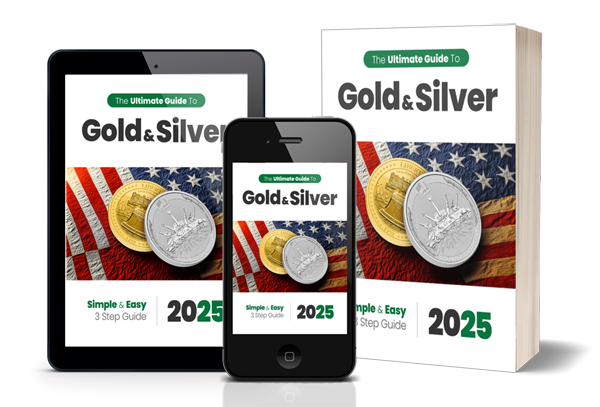
You can take control of your financial future as a federal employee or member of the military by participating in the government’s Thrift Savings Plan.
It could be a good idea to think about including actual gold, silver, and other precious metals in that mix as an additional defense against recessions, monetary devaluations, and economic collapse with this plan in place to provide some basic investment possibilities for retirement.
You can easily convert your Thrift Savings Plan (TSP) into a gold IRA or precious metals IRA by following the instructions in this tutorial. We’ll also go through the differences between these accounts, rules and restrictions, and other crucial details to know before converting your TSP to a gold IRA.
Important Notice!
Before we get more into how to convert your TSP to gold, it’s vital to note that picking a precious metals IRA provider is a crucial financial choice that could have long-term effects on your financial situation.
Our objective is to give you the most accurate and trustworthy information possible to assist you in choosing the best course of action for growing and safeguarding your money right now.
To make your decision easier, we have carefully researched and ranked the top 8 precious metals IRA providers for 2024.

Current Promotions
Our #1 recomendation of gold IRA company is offering up to 10% of your order in FREE silver for a brief period of time. In other words, if you spend $100,000 on metals, you get $10,000 worth of silver for free!
Rating Overview From The Same Company:
- Free Storage for Non-IRA Precious Metals
- Biggest Promotions in the Industry
- Unmatched Customer Service
- No High-Pressure Sales Tactics
- Outstanding Ratings & Customer Reviews
- FREE and Easy IRA & 401(k) Rollovers
- A+ BBB Rating and AAA BCA Rating
- Highest Buy-Back Guarantee
- 2021 Company Of The Year Award

What Is A Thrift Savings Plan (TSP)?
Federal employees have access to a valuable retirement savings tool known as the Thrift Savings Plan (TSP). Established in 1986, the TSP serves as a crucial component of the financial security package offered to those in government service, providing the same tax benefits as a conventional 401(k).
What’s noteworthy is that even members of the military and postal service can avail themselves of the TSP, mirroring their counterparts in the private sector who benefit from 401(k) and 403(b) plans.
Unlike defined benefit plans, which guarantee a specific pension amount in retirement, defined contribution plans like the TSP don’t assure you a fixed rate of return on your retirement investments. This inherently makes them riskier. The value of your retirement funds is contingent on the performance of your investments.
Similar to 401(k)s, the TSP operates by allowing you to defer a portion of your compensation, redirecting it into the retirement account, commonly referred to as the Thrift Savings Fund. This fund is overseen by a board of presidential appointees. Additionally, your program may offer matching contributions from your employer.
If you’re ready to take action
TSP Investment Options
Although the Thrift Savings Plan (TSP) has some limited investment possibilities, it is a fantastic way to save for retirement. You can choose from a variety of different asset pools, but you have no influence over what’s inside. This means that in order to protect your future, you must carefully combine and match your preferences.
A TSP provides a number of investing possibilities that can contribute to long-term monetary security. These programs consist of the Common Stock Index Fund, the Fixed Income Index Fund, and the Government Securities Fund. There are also lifecycle funds, which are a combination of different funds.
An overview of the most popular TSP choices is shown below:
- G Fund: Government Securities
- F Fund: Fixed Income Index
- C Fund: Common Stock Index
- S Fund: Small-Cap Stock Index fund
- I Fund: International Stock Index Fund
If you’re an employee, you may either choose a Lifecycle fund depending on the date you want to retire or take charge and construct your own investment mixes using these five individual funds.
If you’re ready to take action
Thrift Savings Plan Vs A 401(k) Plan
The TSP and 401(k) plan share many similarities when it comes to saving for retirement. Both options let you put money aside before taxes for your elderly years, but how do they differ?
Generally speaking, employees of the government or the federal government can use their TSP option, while employees of the private sector can benefit from a regular 401(k).
It’s worth noting that contributions from both plans are eligible for tax breaks when making withdrawals after the age 59 ½. Note that RMDs (Required Minimum Distributions) start kicking in once an individual hits 70 ½.
Can I Convert My TSP To Gold?

You might not have much luck with a TSP if you want to invest in precious metals at first. Still, there is hope!
Your money can be simply transferred into another qualifying employer plan or Individual Retirement Plan (IRA), such as a gold IRA or precious metals IRA, once you’ve retired from government employment without having to worry about taxes.
This offers knowledgeable investors the option to ultimately acquire assets in gold, silver, or even cryptocurrencies.
With that said, let’s take a closer look at the process of rolling over your TSP into a gold IRA or similar qualified retirement account.
TSP Rollover Regulations
When departing from federal service with a Thrift Savings Plan (TSP), the recommended course of action is to roll over your funds into an IRA, 401(k), or another qualified retirement plan. However, when transferring funds from one retirement account provider to another, it’s advisable to opt for a direct rollover.
In a direct rollover, also referred to as a transfer, you don’t receive a check for the distribution. Instead, your TSP plan provider facilitates the direct transfer of the funds into your new IRA account.
It’s important to note that if you choose to perform an indirect rollover, where you receive the funds from your TSP before transferring them to your IRA, you have a limited window of 60 days to fund your new IRA. Failure to do so within this timeframe may result in the IRS treating the distribution as a taxable event.
The tax regulations surrounding TSP rollovers can be intricate, so it’s highly advisable to seek guidance from a qualified tax advisor before attempting a rollover.
Furthermore, during the transition process, it’s generally not recommended for individuals to invest in assets such as stocks or bonds using their distribution. But unlike other investments, you don’t need to worry about counterparty risk when it comes to gold, silver, and other precious metals since they’re physical assets.
Precious metals have held intrinsic value for millennia and have demonstrated resilience in maintaining their worth over time. In summary, they can offer genuine security in a volatile economic market.
TSP Plan To A Gold IRA Advantages
Rolling over your savings into a self-directed IRA allows you more freedom to choose the assets you want to invest in, including precious metals, if you feel that your TSP or 401(k) is restricting your investing possibilities.
Even decisions about whether to change your portfolio are constrained in the Thrift Savings Plan, which limits your options further. There is no doubting that, whether compared to TSPs or 401(k)s, self-directed IRAs offer investors more flexibility and independence.
So set yourself up for greater success and more freedom through a >>>gold IRA or precious metals IRA!
Important Information About Rolling Over Your TSP Into Gold IRA
If you’re considering rolling over your TSP account, it pays to move it into another tax-deferred account so you can keep making contributions.
Transferring funds from your TSP into a Self-Directed IRA offers a sensible alternative. With this option, you can include physical precious metals, and these investments remain untaxed until you decide to make contributions.
Otherwise, if transferred to a regular or Roth account, the account value must be declared as part of your income for the current year, which makes it taxable.
How To Rollover Your TSP Into A Gold IRA
It’s now simpler than ever to convert your TSP into a gold IRA with the assistance of a trustworthy precious metals provider.
In brief, the procedure is as follows:
- Step 1. To get started, request this FREE Gold IRA Guide from our #1 recommendation for gold IRA company and learn how to best invest in precious metals.
- Step 2. In the next step, you’ll be contacted by a Precious Metals Specialist to ask questions.
- Step 3. If you want to move forward, you’ll then speak with an IRA Specialist who will ask about your current retirement account and help to confirm rollover eligibility.
- Step 4. And if eligible to convert your existing retirement funds into a gold IRA, you’ll need to create an account with a custodian capable of handling self-directed IRAs.
- Step 5. Once the paperwork is done, you’ll roll over funds from your existing retirement account to a new Self-Directed IRA.
- Step 6. You can now purchase your precious metals.
TSP To Gold IRA: FAQ
What Is The Thrift Savings Plan Contribution Annual Limit?
A portion of each paycheck or even a percentage of your income put into your TSP, up to an annual cap of $22,500 as of 2023, is one of the finest strategies to build up your future savings. Additionally, if you’re over 50, you might be qualified for those additional, well-earned $7,500 “catch-up” payments.
Who Is Eligible For Matching Contributions?
Whether you are enrolled in the more recent Federal Employees Retirement System (FERS) or the more venerable Civil Service Retirement System (CSRS) determines your eligibility for matching contributions. You are a member of the FERS and will get matching contributions if you were employed after 1987. Individuals covered by the earlier CSRS system are not eligible for matching contributions because it is more comparable to a pension.
Can I Roll Over My TSP Into A Gold IRA?
No, but after leaving a position in the public sector, you can easily transfer your savings into another qualified workplace plan or an Individual Retirement Account (IRA), such as a gold or precious metals IRA, without incurring any tax consequences.
What’s The Different Between Indirect Rollover & Direct Rollover?
In the case of an indirect rollover, you initiate the withdrawal of funds from your TSP and subsequently deposit them into one or more IRAs. It is crucial to designate this deposit as a rollover rather than a contribution, as contributions are subject to an annual limit of $22,500 (with an additional $7,500 allowance for those aged 50 and over).
When considering an indirect rollover, it’s of paramount importance to complete the process within a 60-day window to avoid potentially substantial IRS penalties. Failing to do so can result in significant tax liabilities and may prevent your retirement funds from enjoying the tax-sheltered benefits they are entitled to.
Conversely, a direct rollover, often referred to as a trustee-to-trustee transfer, facilitates the movement of TSP assets or cash directly into one or more IRAs. You do not physically handle the funds; they are directly transferred into the new account(s). This approach eliminates the need to worry about the 60-day deadline, making it the preferred and more secure method for the rollover process.
Why Should You Avoid Indirect Rollovers?
Indirect rollovers should be avoided because they are taxable. If the rollover isn’t finished within the 60 days, the plan is required to withhold 20% to pay taxes. In other words, if you want to avoid paying taxes on pretax contributions and gains plus a 10% tax penalty if you’re under 59.5, you need to deposit the money within 60 days.
What Plans Allow Gold Bullion?
Precious metals, such as gold bullion, present a special choice for people wishing to diversify their retirement investments. In a gold IRA or a personal 401(k), for example, you can hold actual gold coins and bars.
Additionally, a self-directed IRA makes it possible to invest in additional commodities like silver, platinum, palladium, and even cryptocurrencies.
Should I Choose To Invest In Physical Gold Or Paper Gold?
The advantage of physical gold lies in its simplicity, as its value is primarily determined by the prevailing COMEX price of gold.
On the other hand, the value of paper gold is influenced not only by the COMEX price of gold but also by additional factors such as the competence of the individual mining company’s management, their exploration efforts, local labor costs, and the impact of geopolitical conditions and regulations in the region.
One of the primary risks associated with owning paper gold is that it lacks backing by physical gold; instead, it represents a commitment to deliver gold at a future date. This reliance on the issuer of paper gold means that investors must trust that the issuer possesses enough physical gold to meet their obligations. If the issuer falls short on gold reserves or goes bankrupt, investors could potentially lose their entire investment.
Furthermore, it’s important to note that physical gold has maintained its value throughout history and has never become worthless. This historical track record underscores why owning gold stocks can be considered riskier compared to holding physical gold.
For more detailed information on this topic, you can refer to our article on “Paper Gold Vs. Physical Gold: What Is The Better Investment?“
What Are The Benefits With An IRA Compared To A TSP?
Your retirement savings are more flexible and under your greater control with an IRA. With an IRA, you have access to additional investing options than just stocks or TSP mutual funds, such as REITs (mutual funds that invest in commercial real estate), giving you the chance to diversify your portfolio.
Furthermore, a TSP plan does not offer any extra choices, like as gold and commodities. Therefore, consider starting an IRA if you’re searching for more variety when it comes to investing for retirement security.
What Are The Disadvantages With An IRA Compared To A TSP?
IRA expense ratios are frequently greater. Lower costs are becoming more accessible as index fund competition increases. TSP’s product, however, still has one of the lowest costs available at just 0.04%.
Investors should be aware that the low cost benefit may have a trade-off in that profits on investments made through TSP may wind up being much lower than those made through other providers.
If you’re ready to take action
Top 8 Gold IRA Companies
We have analyzed and ranked the top 8 precious metals firms in the industry for regular purchases and gold IRAs in order to assist you in choosing the best company to safeguard and increase your wealth with right now.
We have given each organization a rating based on a number of criteria, such as BBB/BCA ratings and complaints, client testimonials, annual costs, the availability of precious metals, storage choices, promotions, and buy-back schemes.
4.98/5
- Annual Fees (IRA): $280-330
- Minimum Investment (IRAs): $25,000
- Preferred Custodian: Equity Trust

4.95/5
- Annual Fees (IRA): 0
- Minimum Investment (IRAs): $50,000
- Preferred Custodian: Equity Trust

4.88/5
- Annual Fees (IRA): $280-330
- Minimum Investment (IRAs): $10,000
- Preferred Custodian: Equity Trust

4.88/5
- Annual Fees (IRA): 0
- Minimum Investment (IRAs): $10,000
- Preferred Custodian: Equity Trust

4.44/5
- Annual Fees (IRA): 230
- Minimum Investment (IRAs): $2,000
- Preferred Custodian: Equity Trust
4.90/5
- Annual Fees (IRA): 175
- Minimum Investment (IRAs): None
- Preferred Custodian: Equity Trust

Overall Rating
4.3/5
- Annual Fees (IRA): $0
- Minimum Investment (IRAs): $10,000
- Minimum Investment Cash Sales: None

4.0/5
- Annual Fees (IRA): 0
- Minimum Investment (IRAs): $10,000
- Preferred Custodian: Equity Trust
















